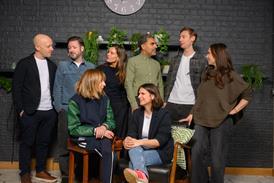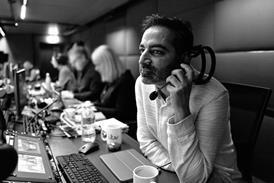A lack of original content and funding issues have slowed growth, but progress is still being made, says Adrian Pennington.
With the number of 3D-ready displays sold in the UK predicted to triple by the end of 2012 to 2.3 million, and with acquisition of 3D content opening up internationally, the market for 3D TV continues to grow, albeit slowly.
The economic climate is playing its part in dampening down display sales, the consumer is being exposed to too much ‘filler’ material on channels because of a dearth of original content, while poorly converted or produced stereo films are damaging the perception of 3D’s value at the box office.
For many, the trajectory charted by HD remains the most pertinent guide.
It took more than a decade from HD’s introduction for it to become a mature product, so we should not be impatient for 3D TV to reach those heights in only its second year.
“We are in a period where everyone doubts its viability, but we have moved on from experimentation to talking about programming content,” says Duncan Humphreys, creative director at CAN Communicate.
“We are talking less about the technology, more about ideas, production values and storylines that work in 3D.”
CAN’s co-pro with Renegade Pictures of 10 x 60-minute Safari 3D for Discovery’s 3net is an example of the move towards mainstream formats.
Gameshows and drama series are also being touted.
“The challenge is for innovative producers to take on the mantle and make unique programming that is enhanced by 3D, rather than filling airtime with 3D as a badge,” says Nineteen Fifteen founder Vicki Betihavas.
The spectacle of the Olympics in 3D could galvanise consumers into buying 3D-ready displays, but the wider issue in sport is funding.
“Manufacturers will only underwrite productions for so long. It’s about finding a route to market that can fund itself,” says Humphreys.
“Part of the answer lies in selling the 3D broadcast rights separately from the 2D ones so that 3D finds its own value in the market.”
Across genre, costs can be double those of a 2D HD show, particularly if high volumes of CGI are involved, but the perception that 3D is high risk and high cost needs to be tackled, says Andrew Shelley, operations manager at On Sight.
“Producers are able to strip back the component parts of a 3D production in terms of processes, equipment and people to make an efficient and quality production,” he adds.
Those that have produced 3D content for television, such as OSF, Leopard Films, Renegade, Colonial Pictures and Atlantic Productions, are small- or medium-sized indies.
Yet larger producers with repeat or volume commissions have yet to find a route, although it could be argued that Tigress Productions’ (part of Endemol) 60-minute natural history show Beautiful Freaks breaks that mould.
For David Pounds, managing director of Electric Sky, producer of 3D extreme sports series High Octane, production is becoming more affordable thanks to innovations in technology.
“New Sony and Panasonic 3D camcorders are much more manageable than rigs - although rigs are still necessary for certain projects,” he says.
“Media Composer 6 contains stereo tools, which makes 3D more readily available in edit suites. Overall, 3D tools are much more accessible.
“Having said that, producers need to seriously consider whether their company has the right sensibility and right people on board to grasp 3D. Don’t treat it as a novelty or after-thought.”
He predicts the 3D TV market will remain largely static over the next year: “It is almost impossible to fund 3D TV without a 2D channel partner backing you in some shape or form.”
Betihavas agrees: “If your programme can stack up internationally in 2D, then you have a good chance of getting it funded.”
The buzz from Mipcom was that several broadcasters in Europe and Asia have 3D in their plans, but funding sources are limited at the moment.
Discovery Europe commissioned its first tranche of 3D to play on Sky 3D and 3net in the US, and in preparation for a mooted full channel launch on the Sky platform.
The BBC also continues to experiment with various genres. Next up is the live 3D TX of the Strictly Come Dancing final. It is occasional events such as this and BBC Earth featurescale productions Walking With Dinosaurs 3D and The Enchanted Kingdom, as well as sport (expanded 3D coverage at Wimbledon 2012 is planned), that dominate the broadcaster’s strategy.
“Internationally branded, event-led 3D projects are most likely to sell, although the global 3D TV market is very fickle,” confirms Paul Berrow, chief executive of distributor Log Media.
Most stakeholders, Sky included, maintain that 3D content will only fly with user-friendly displays that don’t require glasses.
The introduction of tablets, smartphones and games consoles with 3D screens could be a “game-changer”, suggests Anthony Geffen, creative director of Atlantic Productions and Sky joint-venture Colossus Productions, which is readying the 3 x 60-minute Kew 3D for Sky.
Betihavas adds: “We need displays to get to a point where they don’t need cumbersome glasses, and where content truly is a better experience in 3D over 2D.
“There are a number of funding and distribution options; you just need to look a little harder for them, and definitely think outside the box.”
Case study: London 2012 Olympics
After much speculation, the International Olympic Committee (IOC) finally announced that up to 300 hours of the London 2012 Games will be captured in 3D.
Even if that is a fraction of the total 5,000 hours of coverage, it can no longer be considered an experiment or just for archive, as seemed the most likely scenario six months ago.
The IOC has received feedback from major rights holders including the BBC, NBC and ESPN in support of a sizeable commitment to 3D production.
Events at 14 venues will be covered, enough for Olympic Broadcast Services (OBS) to create a 10-hour daily mix of live footage and highlights.
Three outside broadcast firms will produce this separately from the 2D broadcast.
Each mobile unit will carry 12-14 rigs for around 40 camera positions.
About 20 newsgathering crews sporting Panasonic dual-lens camcorders will also contribute. These cameras will also be used track- or pool-side to get nearer to the athletes.
The opening and closing ceremonies will be covered, as will popular events such as gymnastics and track and field, in addition to sports such as swimming and canoeing, which have not previously been captured in 3D.
OBS will be contracting a 3D production specialist and will work with official sponsor Panasonic to select the right candidate.
Hopefuls include US rig developers Element Technica; Belgium OB giant Alfacam, which is already supplying the bulk of facilities to OBS; and Cameron Pace Group, which produced the X Games in 3D for ESPN earlier this year. CAN Communicate is likely to be involved in recorded 3D Olympics programming.
Timeline: A year in 3D
April
Formation of technology specialist Cameron Pace Group (CPG) by James Cameron and Vince Pace, targeting broadcast production companies
Sky appoints John Cassy as director of 3D
Sky produces 10-minute 3D short of the royal wedding
May
Atlantic Productions’ Flying Monsters 3D for Sky wins Bafta for Specialist Factual
Launch of Telegenic’s third 3D OB truck in time for Sky Sports 3D production of the UEFA Champions League final
June
Sky Arts airs two hours of live music in 3D for three nights from the Isle of Wight festival
July
Discovery Europe orders first 3D shows in the UK. Signs distribution deals with Sky and Virgin Media
BBC broadcasts three matches from Wimbledon’s centre Court in 3D, its first live 3D broadcast
Sky teams up with Atlantic to create Colossus Productions, a joint venture specialising in 3D
September
Merger of rig developers 3Ality Digital and Element Technica into 3Ality Technica
October
First UK horseracing event fi lmed in 3D, by CAN Communicate at Ascot for At The Races
December
BBC films the final of Strictly in 3D


























No comments yet